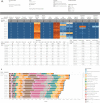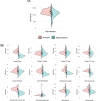Automating Anesthesiology Resident Case Logs Reduces Reporting Variability
- PMID: 36545371
- PMCID: PMC9753964
- DOI: 10.46374/volxxiv_issue4_mccabe
Automating Anesthesiology Resident Case Logs Reduces Reporting Variability
Abstract
Background: The Accreditation Council for Graduate Medical Education (ACGME) case log system for anesthesiology resident training relies on subjective categorization of surgical procedures and lacks clear guidelines for assigning credit roles. Therefore, resident reporting practices likely vary within and between institutions. Our primary aim was to develop a systematic process for generating automated case logs using data elements extracted from the electronic health care record. We hypothesized that automated case log reporting would improve accuracy and reduce reporting variability.
Methods: We developed a systematic approach for automating anesthesiology resident case logs from the electronic health care record using a discrete classification system for assigning credit roles and Anesthesia Current Procedure Terminology codes to categorize cases. The median number of cases performed was compared between the automated case log and resident-reported ACGME case log.
Results: Case log elements were identified in the electronic health care record and automatically extracted. A total of 42 individual case logs were generated from the extracted data and visualized in an external dashboard. Automated reporting captured a median of 1226.5 (interquartile range: 1097-1366) total anesthetic cases in contrast to 1134.5 (interquartile range: 899-1208) reported to ACGME by residents (P = .0014). Automation also decreased the case count interquartile range and the distribution approached normality, suggesting that automation reduces reporting variability.
Conclusions: Automated case log reporting uniformly captures the resident training experience and reduces reporting variability. We hope this work provides a foundation for aggregating graduate medical education data from the electronic health care record and advances adoption of case log automation.
Keywords: Anesthesiology training; technology in education.
Conflict of interest statement
Conflicts of interest: None
Figures



References
-
- Accreditation Council for Graduate Medical Education ACGME Program Requirements for Graduate Medical Education in Anesthesiology. https://www.acgme.org/globalassets/pfassets/programrequirements/040_anes... Accessed September 1, 2020.
-
- Simpao A, Heitz JW, McNulty SE, et al. The design and implementation of an automated system for logging clinical experiences using an anesthesia information management system. Anesth Analg . 2011;112(2):422–9. - PubMed
-
- Yamamoto S, Tanaka P, Madsen MV, Macario A. Analysis of resident case logs in an anesthesiology residency program. A A Case Rep . 2016;6(8):257–62. - PubMed
-
- Accreditation Council for Graduate Medical Education ACGME Resident Case Log System. https://www.acgme.org/data-collection-systems/case-log-system/ Accessed September 1, 2020.
LinkOut - more resources
Full Text Sources
